[Today we welcome guest writer Lyonel Perabo joining us from Northern Europe. The Wild Hunt is always seeking new voices and welcomes guests nearly every month. By doing so, we expand our ability to share the many diverse experiences found within the collective Pagan, Heathen and Polytheist communities worldwide. Submissions are always accepted. If you enjoy reading these guest pieces, consider donating to our Wild Hunt Fall Fund Drive. We are completely reader-funded, and all your donations go directly back to a writers, including guests, and to bringing you their stories! Donate today. Thank You.]
In 2009, the Isogaisa festival was established by Ronald Kvernmo, a Sámi from the Norwegian side with a long interest in his people’s culture and spirituality and, more specifically, shamanism. Until the modern era, the Sámi people were, for the most part, Pagans whose complex religious beliefs and concepts were often embodied by their ´noaidi´ (´shamans´). Even after the effective colonization and conversion of Sápmi (´Sami-land´), elements from this Pagan culture were passed on in some form or another until the present day.
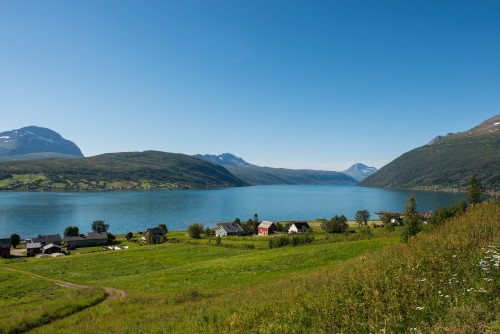
The festival takes place on the shores of the idyllic Lavangen Fjord situated at 68 degrees latitude North in Northern Norway. [Photo Credit: Linnea Nordström]
In Sámi society we have lost a lot of our culture, in part due to Norwegianization and state-sponsored racism, but now we have come, in the last twenty, thirty years, to a new time where Sámi culture is advancing and people can feel proud of their heritage.
The concept behind Isogaisa is unique in the sense that it is the only festival focusing on Sámi traditional religion. Other Sámi festivals promoting Sámi culture are widespread in the Northern corners of Norway, Sweden, and Finland, but none are as resolutely Pagan as Isogaisa. While Sámi traditional practices and religion are the main focus of the festival, Isogaisa has grown to welcome representatives and practitioners of other cultures as well. For Kvernmo, it is a token of hospitality and friendship and it is both natural and practical. He said:
It is important for Sámi people to have opportunities to advance their culture, however, we have lost a few things along the way. In order to recover those practices, we have to borrow them back from our neighbors. Our culture isn’t stagnant, it’s dynamic and we have been working closely for a time with some of our Northern neighbors like the Nenets and Kidlin Sàmi from Russia.
Sharing Faiths
At this year’s festival, another group in the spotlight were Latvians. A dozen Pagan Latvians, including members of the Baltic musical group Tai Tai, were invited to give workshops and presentations about their ancestral religion, crafts and music. During one such event, the members of Tai Tai performed a number of traditional songs, games, and dances. They explained their origins in front of a group of festival-goers who had were visiting from Russia, Norway, Finland and the U.K.
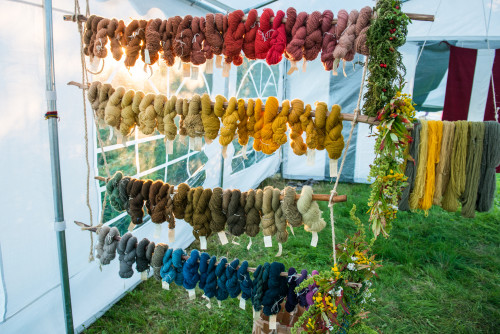
Latvian guests dyed yarn in a traditional way, using wild herbs. The festival serves as a way to share knowledge about traditional crafts. [Photo Credit: Linnea Nordström]
As a result, and even taking into consideration the recent Sámi cultural renewal of the past few years, age-old prejudice is sometimes still present in these regions. In Finland, for example, it is still common for non-Sámis to dress in (often poor-quality) Sámi traditional costumes when dealing with foreign tourists. The dichotomy between state-enforced discrimination and the packaging of a consumer-friendly Sámi culture represents the official ´Sámi policy´ of the Fenno-Scandinavian states during most of the 20th century.
Eva and Peter Armstrand represent one shining illustration of the way the festival works toward the sharing and celebrating of different cultures. While both of them are Swedish citizens, Peter is a Sámi with roots in the northern part of the country and Eva is an ethnic Swede from the south. They have been a couple and a team for several years now and have been practicing spirit-working, healing and traditional crafts together under the name Team Fourbears. In between a ceremony and a workshop, Eva was able to explain how they have been able to, quite literally, marry two distinct traditions:
In the beginning, these really were just one single tradition. Over time, we developed different names for the Gods and spirits but deep down, they really are the same figures. For us, it doesn’t feel strange, to blend these two traditions, on the contrary, it feels quite natural.
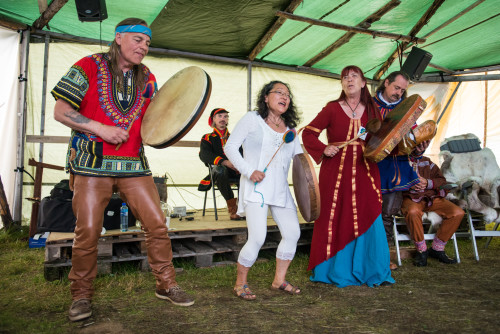
Will Rubach, Heidi Kim and Eva and Peter Armstrand perform at closing ceremony. Festival leader, Ronald Kvernmo watches from the stage. [Photo Credit: Linnea Nordström]
Constructive Communion
During the four days of the Isogaisa festival, shamans, Pagans and other spirit-workers, coming from Northern Europe and beyond, gathered, exchanged, and worked together. Due to its collaboration with various alternative religious associations, Isogaisa has reached a certain prominence within the European alternative religion scene. Situated in the breathtakingly scenic Lavangen fjord, not far from the Norwegian-Swedish border in the Northern county of Troms, the festival is uniquely situated to be a meeting place with an international dimension. A good deal of participants and attendees are Sámi attempting to reconnect with their ancient traditions. Others are clearly closer to the New Age movement, and some could even be considered Reconstructionists.
What’s important though isn’t what sets the diverse Isogaisa crowd apart, but what brings them all together: a genuine desire to listen and learn from others. In a way, the festival could almost be considered a global networking event where people, who would otherwise never have the opportunity to meet, can hang out and build bonds. For example, members of the Latvian and Russian Sámi delegations spent most of the festival together communicating in Russian and ended-up professing brotherhood during the festival’s closing ceremony. Such genuine and beneficial outcomes are aided by the fact that the festival’s strict no-alcohol and no-drug policy.
The main ceremonies took place in the festival’s main Lavvu, a type of traditional Sámi tent. Most, if not all the courses, workshops and concerts take place within such Lavvus, which also make ideal shelter in case of bad weather. The festival central Lavvu is a massive structure, connecting no less than four such tents thus creating a central meeting space where hundreds can gather. This is also where the festival’s closing ceremony took place.
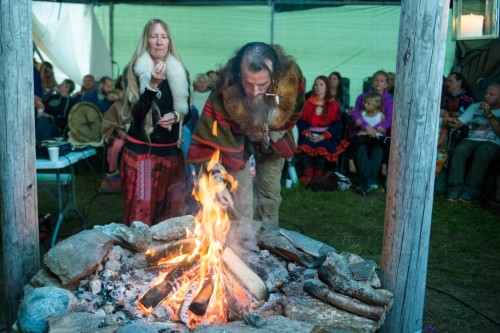
Tara LeAnn Eriksson and Tobias Kramp make an offering to the Holy Fire during the festival’s closing ceremony. [Photo Credit: Linnea Nordström]
Among all the performers, Russian Sámi dancer Semen Bolshunov probably made the strongest impression. Outfitted in various animal skins, he performed a dance inspired by the shamanic traditions of his people, running around the festival sacred fire before collapsing on a pile of reindeer skins. Another highlight of the ceremony was the birthday celebration for Danish Shamanic Union member Per Søager. After being presented with a cake, he ended up being serenaded by no less than a dozen versions of ´Happy Birthday´ sung in many languages.
The closing ceremony ended with the performance of Eirik Myrhaug, a respected Sámi Shaman who led a final blessing of the festival grounds. And, when he finished, the 6th annual Isogaisa festival came to an end. All in all, Isogaisa lived up to its reputation, providing a fertile ground for those interested or involved with the Shamanistic and Pagan practices from Northern Europe and beyond.
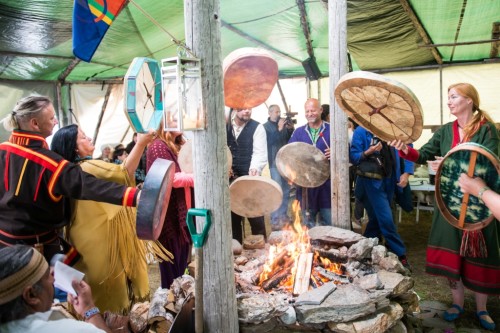
Shamans hold their drums over the Holy Fire in order to warm them and obtain a clearer sound whiel drumming. [Photo Credit: Linnea Nordström]
* * *
[Lyonel Perabo is a MA student currently enrolled in the Old Norse Religion program at the University of Iceland. He has written for various news websites, blogs and student magazines in the Nordic countries Lyonel is currently working on his Master’s thesis, which seeks to analyze the way North-Scandinavian populations were perceived in Saga Literature and works as a tourist guide and local History blogger in the town of Tromsø in North-Norway.]
The Wild Hunt is not responsible for links to external content.
To join a conversation on this post:
Visit our The Wild Hunt subreddit! Point your favorite browser to https://www.reddit.com/r/The_Wild_Hunt_News/, then click “JOIN”. Make sure to click the bell, too, to be notified of new articles posted to our subreddit.
This looks like a wonderful event to attend!
It indeed was, we have lots of dinky charming festivals in this part of the world.
Very inspiring. 🙂 Also, I am incredibly jealous of the fact that the University of Iceland actually offers an MA in Old Norse Religion!
Happy you liked it! And yes, the only degree in Norse Religion is taught in Iceland, it’s amazingly great and eye-opening!
Fascinating! Hope to see more articles like this one.
Thanks for the feedback ! I hope I get the chance to write more articles in the future!
Please do!
I most certainly will try to do so. But I’ll have to finish my thesis first !